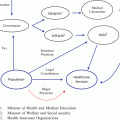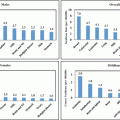Fig. 23.1
Cancer mortality profile (Source: World Health Organization—cancer country profiles; Romania, 2014)

Fig. 23.2
Age-standardized cancer mortality trends (Source: World Health Organization—cancer country profiles; Romania, 2014)
Among all types of cancer, lung cancer has the greatest incidence in men (with 9317 cases), followed by colorectum (5760) and prostate cancer (4532), while in women breast cancer has an incidence of 8981 cases, double than colorectum (4496) and cervical cancer (4343) that follows (Fig. 23.3).


Fig. 23.3
Cancer incidence (Source: World Health Organization—cancer country profiles; Romania, 2014)
When looking back in time, before 1989, during the communist era, the Party’s health program appraised health as an essential “factor for social and economic development […] to satisfy in the best conditions the population life requirements, harmonious development, physical, intellectual and moral capacity, to ensure a full work and creative of every member of society.” [6] Despite the communist slogans, health wasn’t a real priority of policy makers. Thus, the only legal provision regarding population healthcare provision during this period was a law issued in 1978.
Healthcare services were provided by a centralized state system and the full costs were covered by the state. There were also healthcare services requiring direct out-of-the-pocket payment, but also belonging to the government-owned units. Therefore, one of the communist heritages is the common belief that the state should provide healthcare for free and for all.
The medical education was quite well developed, provided through vocational and high schools for undergraduate training, while five universities offered graduate medical studies. The universities are still operating. Basic public education for health was offered in schools and through communist organizations meetings.
There was no program for public health screening to provide a yearly public health evaluation. People were addressing the doctor only when they got sick. There were no national cancer screening program and no public awareness campaigns. However, the industry provided some health checking screening for the workers. The number and type of health checks per year depended on the workplace health risks. One example was the yearly gynecological examination. This examination aimed to prevent the abortion, which was prohibited by law. In fact, the purpose was to identify the pregnant women, to register and supervise them. The gynecologists had confessed after 1990 that through this system were detected most of cervical cancers as well as some of other gynecological cancers, thus representing a form of screening. After 1990, the abortion prohibition was cancelled together with the yearly gynecologic examination, which was considered a communist practice, but it was not replaced by a cervical cancer screening program.
Doctor–patient relation during that period was difficult: patients used to offer money or goods to doctors and nurses thinking that they will receive better healthcare. This is another communist heritage, a matter of mentality, still occurring today.
During the communist regime, there were two main Oncology Institutes, one set up in 1929 in Cluj and the other one in 1949 in Bucharest, cities with well-known medical schools. During that time, there was little investment in the cancer field, nor in early diagnosis, neither in treatment, because cancer was considered a fatal disease [7]. There were no cancer patient organizations or groups, as, except for unions, communist youth organization, and communist party, any other type of organizations were prohibited.
The eventful Romanian revolution that took place in December 1989 meant that Romania paid the democracy with many unnecessary deaths. In the early 1990, NGOs from all over the world offered a lot of support in goods or money without asking anything in change. Therefore, the role of NGOs is, to some extent, still seen to be simply to support people in difficulties and the larger scope of an NGO is still today misunderstood. Volunteering during the communist regime was actually a compulsory involvement required by the party in different activities called patriotic work. Therefore, there is not much tradition in this field and still a misperception of what volunteering and charity mean.
The Impact of Political Changes
After 1990, policy makers and public were focused more on the economic reform of the country, failing to improve the social services and healthcare.
A young democracy, with young politicians, without much or any political education characterized the initial political landscape in the early 1990 that soon led to a multitude of different parties. Politicians’ vanity and personal interests, rather than national/population interest and well-being led step by step to current political instability and poor trust of the voters in Romanian politicians. Health is unfortunately not considered a priority by the authorities, and the civil society is still shy in acting publicly, due to poor solidarity among the constituents.
The Romanian healthcare policy is incoherent due to the following main issues:
(a)
Lack of national long-term healthcare strategy in place: the health ministers changed so often, that Romania can apply for Guinness Book of Records for having 19 health ministers and 20 terms during the last 22 years. For instance, in 2012 Romania had three health ministers. Each minister almost cancelled all what the previous did and attempted to draft its vision but did not have the time to implement it;
(b)
Too much involvement of politicians and lack of technocrats: main positions in the healthcare system, starting from the minister of health down to local health authorities and hospital managers are mostly appointed on political criteria. Most of the healthcare legal provisions were issued without public debate, usually “over the night” without any implementation tools (criteria, norms, etc.) that were issued afterwards quite late, after several months. This situation changed since 2007, when it became mandatory to allow public debates regarding the drafts of legal provisions. Draft of new regulations is posted on the websites of the Ministry of Health and/or National Health Insurance Agency to be consulted by interested stakeholders and public debates are organized.
The healthcare legal provisions are regulating more or less everything in this field (the organization and operation the national health authorities, healthcare national program, etc.). Most of EU recommendation and directives were transposed in national regulations, including the cancer screening Directive, cross-border healthcare Directive, patient rights according to European Charter and most of them are also implemented to the extent that our limited budget allowed.
Romania has a national healthcare social insurance system. Only a part of the population pays the healthcare insurance, but in practice everyone benefits of healthcare services. There is no transparency regarding the amount collected for healthcare insurance, and the amount is collected in a common fund with other taxes and fees, under the administration of the Ministry of Public Finances that decides the amount of the budget allotted to each national activity, including healthcare.
There is a decrease in the number of payers/contributors to the national healthcare insurance found, due to the decline of national economy and the bankruptcy of the large industry. Currently, there are an estimated 3.5 millions payers to national fund of healthcare insurance out of about 18 million beneficiaries of healthcare services.
The Healthcare National Programme
Romania had developed a National Health Programme that also includes the National Programme of Cancer Prevention and the National Programme of Cancer Treatment. The National Programme of Cancer Treatment was implemented in 2002 only after the intense lobbying and advocacy campaign of some of the cancer patients’ organizations existing at that time. These programs were always sub-financed, due to the limited budget available.
In 2007, a reform of the healthcare system was initiated, through a law issued that year. This law has been several times modified. Regarding cancer screening, this law implemented what can be called an opportunistic screening program. Upon request by the individual or by the general practitioner, insured citizens have access to yearly mammography, Pap Test, and PSA testing. People with cancer history in the family can also access additional health checks. These investigations are partially or fully covered by the health insurance depending on the contract with service provider and the available budget. In 2012, a new healthcare law was drafted that is still subject to public consultation.
The budget forecast is drafted at the end of each year for the next year. Usually, the budget is approved in March of each year for the year that was already started. The budget is then distributed for each county and then to each hospital more on political criteria that on evidence base. This leads to inequalities in cancer diagnosis and treatment across the public healthcare system.
With all these very complex regulation in force and in place, the healthcare system is not operating properly, affecting cancer patients; due to the high direct cost of certain interventions for cancer diagnosis and treatment, there are severe limitations in access to high-performance examinations (such as PET-CT or MRI scanning), radiotherapy, or expensive anticancer medications. The radiotherapy equipment is outdated and insufficient. It is estimated that only one third of the patients requiring radiotherapy actually receive it. For certain expensive medications such as monoclonal antibodies or tyrosine kinase inhibitors, the patient needs to receive a special, case-by-case approval for treatment from the National Insurance House—which leads to delays in initiating treatment; not all patients requiring such medications actually receive it.
The Involvement of the Civil Society
The Romanian Cancer Society, the first cancer patient organization in Romania, was set up in 1993 by physicians from Oncology Institute Cluj City and their patients [3]. This is an umbrella cancer patient organization aiming at increasing public awareness, cancer patient education and supports initiatives geared towards improving outcomes for cancer patients, as well as lobbying and advocacy.
The “Common Destinies” Association, the first breast cancer organization, was started in 1996 by doctors and cancer patients as a support group within the professional organization “Romanian Cancer Association.” Other cancer patient organization were initiated in different area of Romania, either as breast cancer support groups, either as umbrella organization most focused in lobby and advocacy. Most of cancer patient organizations were gathered in 2005 under a national umbrella, called Federation of Cancer Patient Associations, the interface between the cancer patients groups and relevant stakeholders [5].
The aggressive advocacy led by these organizations was successful at the beginning. Later, the fact that most groups are 100 % sponsored by pharma industry and because of inappropriate partnership in advocacy campaigns (e.g., national associations of pharma industry), besides the internal disagreement and the fights among the patients’ groups publicly disclosed, had led to lost of the trust of the public and relevant authorities (e.g., Ministry of Health, National Health Insurance Agency, Oncology Commissions, etc.) towards the activity of the cancer patients organizations.
Unfortunately, most of cancer patient organizations didn’t improve enough their capacity to be able to advocate in the same manner as the European Cancer Patient Coalition, to be a real dialog partner and to help strengthen the healthcare system. The communist mentality among the beneficiaries of the health system still persists, expecting the Ministry of Health and National Health Insurance Agency to solve everything over the night [4].
There are however a few cancer patient organizations managed according to the good governance code and ethics of the NGOs. These are accessing non-pharma financing and help develop most of public awareness, organize opportunistic screening programs and are partners of relevant authorities in solving certain issues related to cancer policy.
Stay updated, free articles. Join our Telegram channel

Full access? Get Clinical Tree





